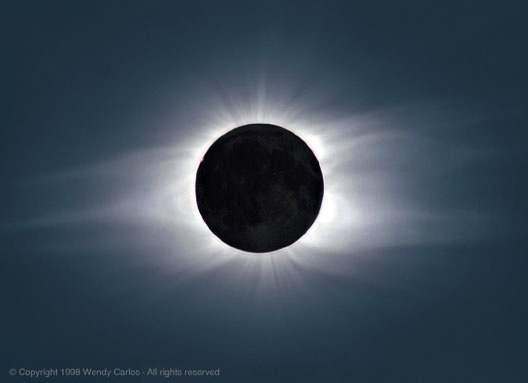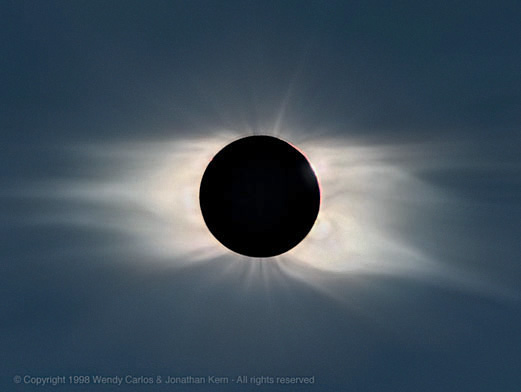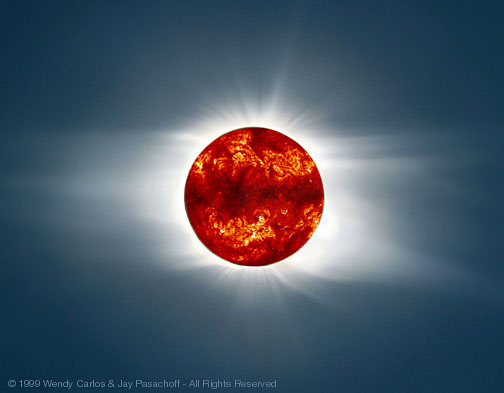|
 Post-Postscript: Post-Postscript:
Since
this page was assembled for Fred's eclipse site, and then
reassembled for our site, another image has been processed
for the 1998 total eclipse. See above. This one was done as
a favor for veteran eclipse chaser, scientist and astronomy
professor, Jay Pasachoff, who teaches at Williams College,
in Williamstown, MA. I've known Jay for more years than we
should count (!), having finally met when we found ourselves
both "captives" on the SS Fairsea, out in the central
Pacific, in 1977 (see my report under the '70s eclipse
section.)
Jay has logged in more
eclipses than anyone else I know of. We're about the same
age, but he got his start before mine, by viewing the 1959
total eclipse from a plane, which professor and solar guru
Donald Menzel had arranged in case of bad weather (it was
dreadful) to view totality a mile or two above Boston, MA. I
was a student at Brown University then, and even though I
lived slightly outside the totality path by 15-20 miles,
with no car and a big exam pending that October morning,
tried at dawn to glimpse what would be a splendid sight: a
weird "thin crescent" sun easing above the Eastern horizon.
Dreary, chilly rain showers and a slight fog dashed my
hopes. But Jay, you "lucky dog", you got to see this first
taste from that small plane! It hooked him, obviously, as
the 1963 one hooked me three and a half years later. (Be
warned, all you totality-virgins...!)
Jay has always taken a very
large, ambitious battery of equipment to his Williams
College eclipse expeditions, and he travels with many
student-assistants, operating a lot of serious experiments
and data-gathering (some later appear in his good texts on
astronomy.) Included is always at least one medium tele lens
35 mm camera, usually a 500 mm one, for general views. The
1998 totality was no exception. He had both a 500 mm tele
taking images on slide film (oops...) and a 600 mm on
negative (good). All off them came out well, although in the
scurry of other experiments, he didn't get any shorter
exposures this time. He'd cordially asked me before to try
working with him, at least compositing some of his shots,
using the many approaches documented on this site more or
less.
This time I didn't want to
refuse him, and since I'd not gotten any good images from my
main cameras from technical foul-ups, it was a generous
offer, and I hoped to learn more doing it (he also "bribed
me" with his newest two books, and a Hi-8 video of the
eclipse... thanx, Jay!) It took nearly 10 months to get to
the actual work of it, due to the unusually difficult year
after the eclipse. But starting last December, I got out all
the Photo-CDs I'd had made from his best negatives and
slides we selected earlier, and started in.
The inner corona was poorly
represented, and it took some mild "fudging", interpolating
inward from the slower-shutter shots that I did have, to
reach the bright limb. I'd seen the eclipse, and had the
other photos above, so was not afraid of messing up. Just
compared as it went on that it still matched reality
extremely closely. From over a dozen original slides and
negs the above composite was assembled. It was one of the
most difficult composites I've made, with the varying
rotational angles and image sizes, film types, and rather
small image sizes (I try to avoid anything shorter than a
750 mm lens and use very fine grain, slow negative film, to
be safe.)
But as you can see, it was
possible to make a very "pretty picture" which was
completely faithful to the originals. Later, Jay got
permission to use the SOHO
satellite Extreme Ultraviolet images of that day to combine
with the corona. I did the work again, carefully filling in
the usual "gaps" of SOHO images (this one is the
Fe XII/Fe
IX, X ratio image at 15:46
UT, 2/26/1998) in the data with reference to the other
images taken near the same time, then scaled and rotated and
composited the sun's surface view into the lunar disk. This
is what you'd see if the moon were instead a special UV
filter and re-channelizer, and allowed you to see the sun's
surface atmosphere, or chromosphere, along with the outer
one, the corona, at the same time. It makes a neat view, and
since I'm rather proud of what came out of the assortment of
varied originals, thought you might be, too.
By the way, it's instructive
to compare this image with the one right above, from Jon
Kern's negatives. He used a textbook-style radial-gradient
filter on his negs, Jay did not. So the brightest part of
coronal detail, those nearest the lunar limb, are
beautifully captured on Jon's collaboration, but the wispier
stuff that make up the polar brushes at the top and bottom
are weak or missing. On Jay's collaboration, nearly the
opposite can be said. The wispy, dimmer details are more
like what the eye saw here, while the extremely bright
details and features are not well shown. Somewhere in
between the two an ideal perhaps exists. Interesting,
no?
A final
word, and pardon if it comes across as a semi-lecture:
this image, perhaps more than any other, demonstrates the
fact that no formula systematized series of steps can
replace a human being who is intelligent, trained and
flexible. I would be at a complete loss to try to give
you a "method of composing symphonies and electronic
soundscapes" for the same reason. A few of you have asked
me for the techniques I use in preparing these images.
The truth is that you could watch the process directly,
just like you might watch a composer write a new work of
music, and go away thinking it was a hodgepodge of stuff,
each time different, improvisational, mysteriously
directed, with nary an equation or algorithm in sight.
And you'd be quite right, *sigh*.
Eventually
I'll find the letter containing "steps" I patiently
listed for Fred Espenak (who is mentioned warmly above)
in a long e-mail reply to him in January of 1998. There's
nothing cute I'm hiding here, any more than in my music
(kids often ask me for a music-making "equipment secret"
for some album or another, and then gape at me when I
plainly reveal that the the way I made this or that was
just by working quite a while at it, doing it over and
over until I got it right -- are schools misleading
children into seeking some ritualistic "tricks" instead
of learning the facts and skills they will need in life?)
Hey, the secret words in both instances are obvious:
"work, time, talent." And realize that not everyone can
do everything equally well, but it's still worth trying,
just like in the Olympics.
Surprised?
Shouldn't be. Fred was kinda annoyed, I think, that so
many of my "methods" were heuristic, specific
goal-oriented, requiring a lot of practice with a Wacom
type pressure tablet, and made about as much sense as
describing how to play the piano in 500 words or less...
;-) My best advice to any of you who wish to try eclipse
imaging is this: Don't depend on any formula or rigid
"method". Mediocre, ordinary results lie on that path.
Learn Photoshop (or the equivalent) to a fare thee well.
Practice with your Wacom stylus, blending and dodging and
burning bits of adjoining or overlapping images, just
like you do in a darkroom. Read a lot about the older
darkroom and newer digital image manipulation methods,
color theory and balance, making and using masks,
retouching, and drawing from life. Be patient. At least
some of you will be able to outdo my attempts here
handily, with repetition and diligence. You'll gather
skills you can use for image work of many kinds, and
you'll have a lot of creative fun in the process!
And for
"the rest of you" (whomever I've not conned into doing
this by my sermonette,) as I've heard in the world of
music: who says an audience serves no active function? We
NEED you, too. Honest.
--Wendy
Carlos
|



![]()